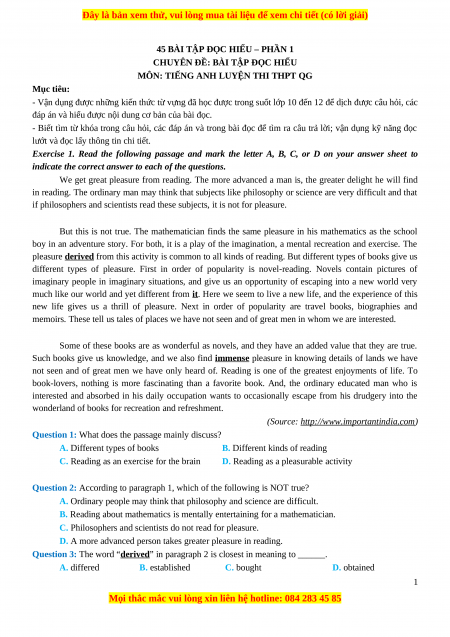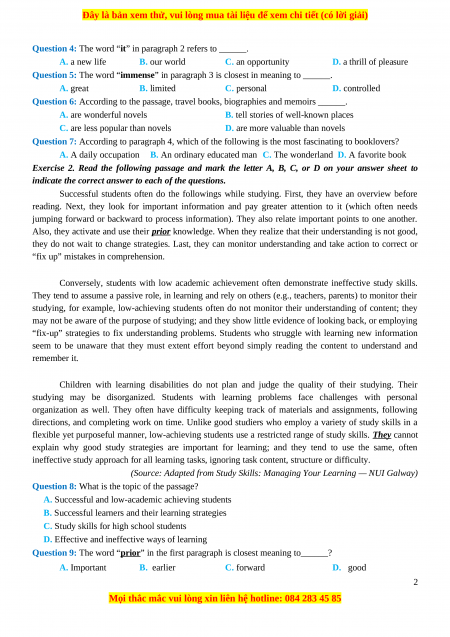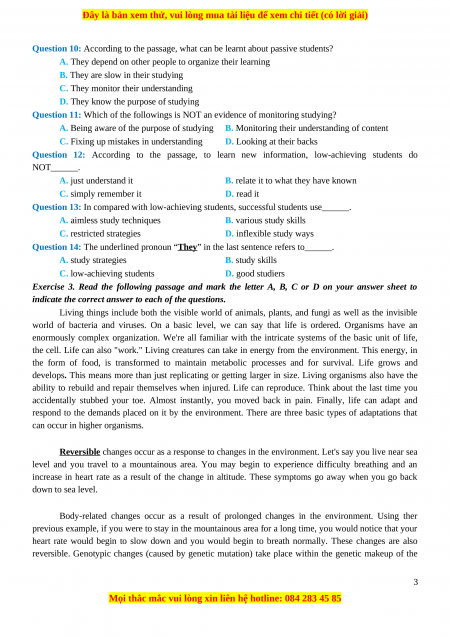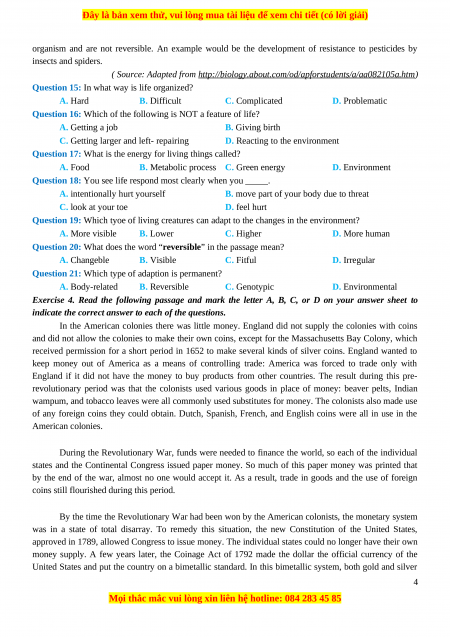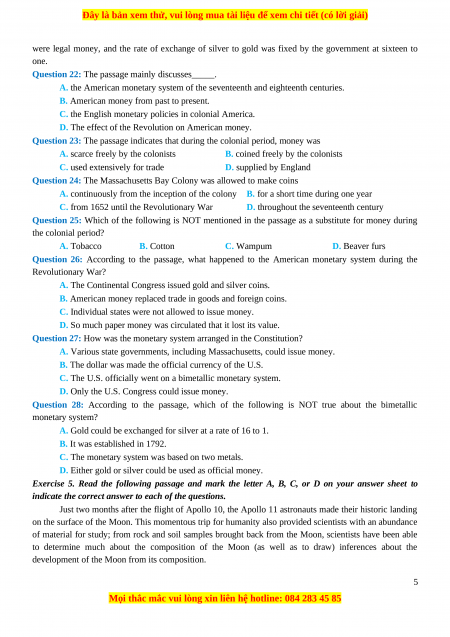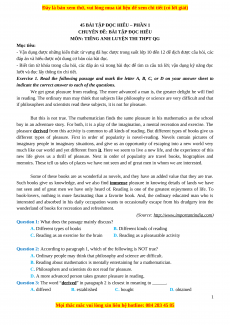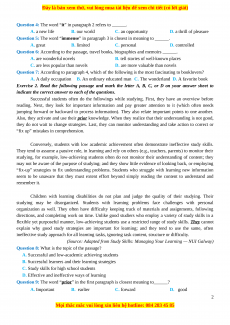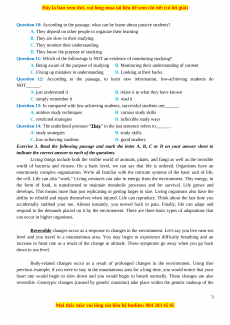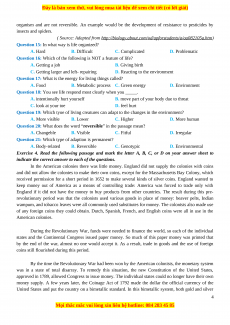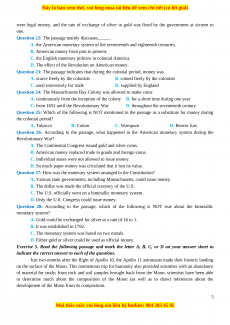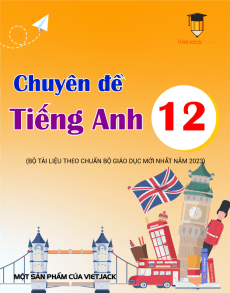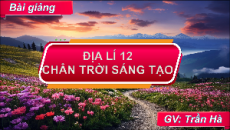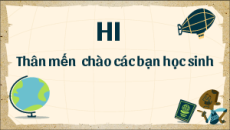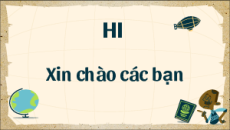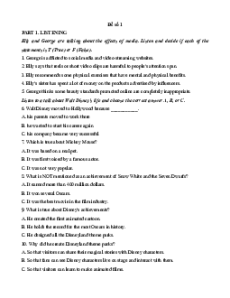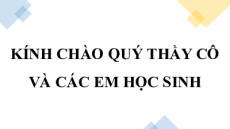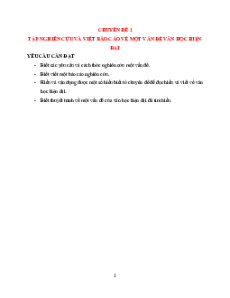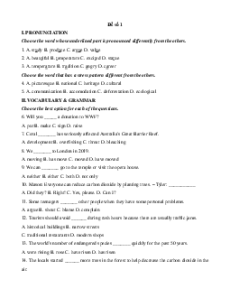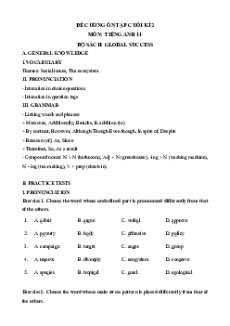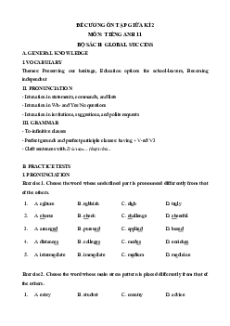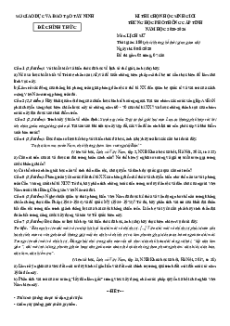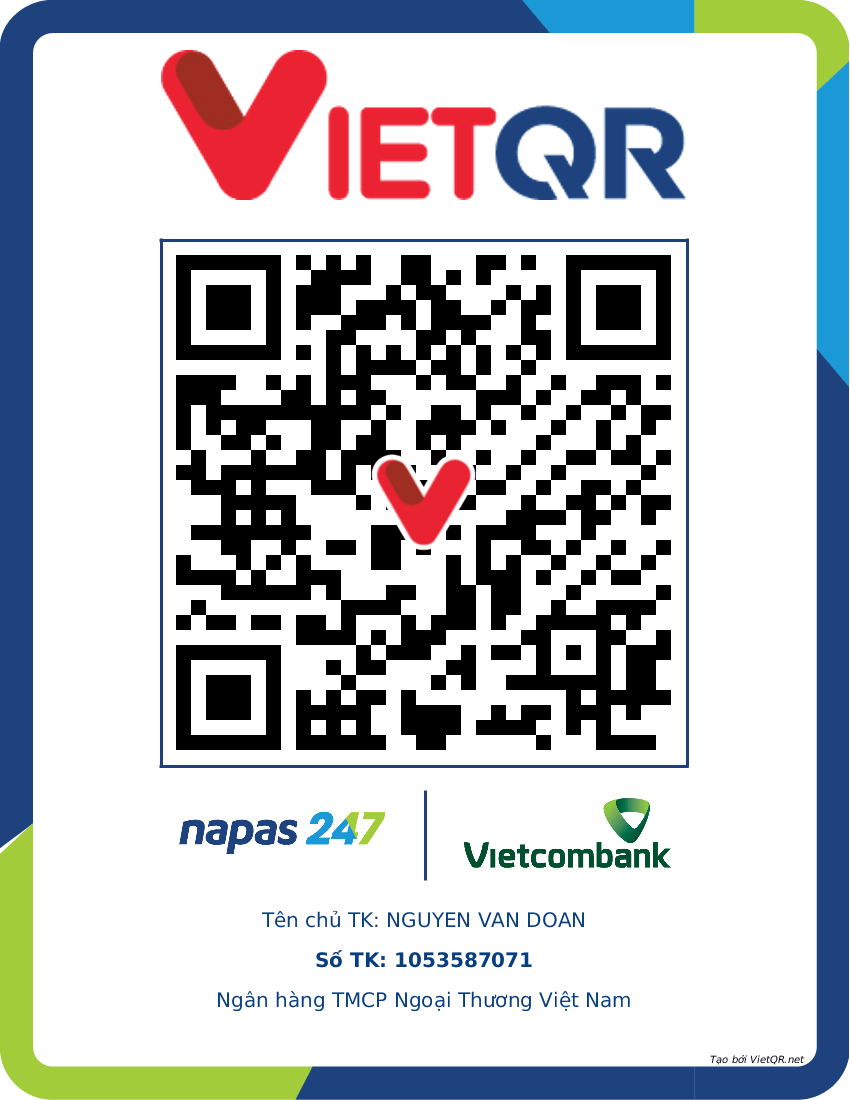45 BÀI TẬP ĐỌC HIỂU – PHẦN 1
CHUYÊN ĐỀ: BÀI TẬP ĐỌC HIỂU
MÔN: TIẾNG ANH LUYỆN THI THPT QG Mục tiêu:
- Vận dụng được những kiến thức từ vựng đã học được trong suốt lớp 10 đến 12 để dịch được câu hỏi, các
đáp án và hiểu được nội dung cơ bản của bài đọc.
- Biết tìm từ khóa trong câu hỏi, các đáp án và trong bài đọc để tìm ra câu trả lời; vận dụng kỹ năng đọc
lướt và đọc lấy thông tin chi tiết.
Exercise 1. Read the following passage and mark the letter A, B, C, or D on your answer sheet to
indicate the correct answer to each of the questions.
We get great pleasure from reading. The more advanced a man is, the greater delight he will find
in reading. The ordinary man may think that subjects like philosophy or science are very difficult and that
if philosophers and scientists read these subjects, it is not for pleasure.
But this is not true. The mathematician finds the same pleasure in his mathematics as the school
boy in an adventure story. For both, it is a play of the imagination, a mental recreation and exercise. The
pleasure derived from this activity is common to all kinds of reading. But different types of books give us
different types of pleasure. First in order of popularity is novel-reading. Novels contain pictures of
imaginary people in imaginary situations, and give us an opportunity of escaping into a new world very
much like our world and yet different from it. Here we seem to live a new life, and the experience of this
new life gives us a thrill of pleasure. Next in order of popularity are travel books, biographies and
memoirs. These tell us tales of places we have not seen and of great men in whom we are interested.
Some of these books are as wonderful as novels, and they have an added value that they are true.
Such books give us knowledge, and we also find immense pleasure in knowing details of lands we have
not seen and of great men we have only heard of. Reading is one of the greatest enjoyments of life. To
book-lovers, nothing is more fascinating than a favorite book. And, the ordinary educated man who is
interested and absorbed in his daily occupation wants to occasionally escape from his drudgery into the
wonderland of books for recreation and refreshment.
(Source: http://www.importantindia.com)
Question 1: What does the passage mainly discuss?
A. Different types of books
B. Different kinds of reading
C. Reading as an exercise for the brain
D. Reading as a pleasurable activity
Question 2: According to paragraph 1, which of the following is NOT true?
A. Ordinary people may think that philosophy and science are difficult.
B. Reading about mathematics is mentally entertaining for a mathematician.
C. Philosophers and scientists do not read for pleasure.
D. A more advanced person takes greater pleasure in reading.
Question 3: The word “derived” in paragraph 2 is closest in meaning to ______. A. differed B. established C. bought D. obtained 1
Question 4: The word “it” in paragraph 2 refers to ______. A. a new life B. our world C. an opportunity D. a thrill of pleasure
Question 5: The word “immense” in paragraph 3 is closest in meaning to ______. A. great B. limited C. personal D. controlled
Question 6: According to the passage, travel books, biographies and memoirs ______. A. are wonderful novels
B. tell stories of well-known places
C. are less popular than novels
D. are more valuable than novels
Question 7: According to paragraph 4, which of the following is the most fascinating to booklovers?
A. A daily occupation B. An ordinary educated man C. The wonderland D. A favorite book
Exercise 2. Read the following passage and mark the letter A, B, C, or D on your answer sheet to
indicate the correct answer to each of the questions.
Successful students often do the followings while studying. First, they have an overview before
reading. Next, they look for important information and pay greater attention to it (which often needs
jumping forward or backward to process information). They also relate important points to one another.
Also, they activate and use their prior knowledge. When they realize that their understanding is not good,
they do not wait to change strategies. Last, they can monitor understanding and take action to correct or
“fix up” mistakes in comprehension.
Conversely, students with low academic achievement often demonstrate ineffective study skills.
They tend to assume a passive role, in learning and rely on others (e.g., teachers, parents) to monitor their
studying, for example, low-achieving students often do not monitor their understanding of content; they
may not be aware of the purpose of studying; and they show little evidence of looking back, or employing
“fix-up” strategies to fix understanding problems. Students who struggle with learning new information
seem to be unaware that they must extent effort beyond simply reading the content to understand and remember it.
Children with learning disabilities do not plan and judge the quality of their studying. Their
studying may be disorganized. Students with learning problems face challenges with personal
organization as well. They often have difficulty keeping track of materials and assignments, following
directions, and completing work on time. Unlike good studiers who employ a variety of study skills in a
flexible yet purposeful manner, low-achieving students use a restricted range of study skills. They cannot
explain why good study strategies are important for learning; and they tend to use the same, often
ineffective study approach for all learning tasks, ignoring task content, structure or difficulty.
(Source: Adapted from Study Skills: Managing Your Learning — NUI Galway)
Question 8: What is the topic of the passage?
A. Successful and low-academic achieving students
B. Successful learners and their learning strategies
C. Study skills for high school students
D. Effective and ineffective ways of learning
Question 9: The word “prior” in the first paragraph is closest meaning to______? A. Important B. earlier C. forward D. good 2
Question 10: According to the passage, what can be learnt about passive students?
A. They depend on other people to organize their learning
B. They are slow in their studying
C. They monitor their understanding
D. They know the purpose of studying
Question 11: Which of the followings is NOT an evidence of monitoring studying?
A. Being aware of the purpose of studying B. Monitoring their understanding of content
C. Fixing up mistakes in understanding
D. Looking at their backs
Question 12: According to the passage, to learn new information, low-achieving students do NOT______.
A. just understand it
B. relate it to what they have known
C. simply remember it D. read it
Question 13: In compared with low-achieving students, successful students use______.
A. aimless study techniques
B. various study skills
C. restricted strategies
D. inflexible study ways
Question 14: The underlined pronoun “They” in the last sentence refers to______.
A. study strategies B. study skills
C. low-achieving students D. good studiers
Exercise 3. Read the following passage and mark the letter A, B, C or D on your answer sheet to
indicate the correct answer to each of the questions.
Living things include both the visible world of animals, plants, and fungi as well as the invisible
world of bacteria and viruses. On a basic level, we can say that life is ordered. Organisms have an
enormously complex organization. We're all familiar with the intricate systems of the basic unit of life,
the cell. Life can also "work." Living creatures can take in energy from the environment. This energy, in
the form of food, is transformed to maintain metabolic processes and for survival. Life grows and
develops. This means more than just replicating or getting larger in size. Living organisms also have the
ability to rebuild and repair themselves when injured. Life can reproduce. Think about the last time you
accidentally stubbed your toe. Almost instantly, you moved back in pain. Finally, life can adapt and
respond to the demands placed on it by the environment. There are three basic types of adaptations that can occur in higher organisms.
Reversible changes occur as a response to changes in the environment. Let's say you live near sea
level and you travel to a mountainous area. You may begin to experience difficulty breathing and an
increase in heart rate as a result of the change in altitude. These symptoms go away when you go back down to sea level.
Body-related changes occur as a result of prolonged changes in the environment. Using ther
previous example, if you were to stay in the mountainous area for a long time, you would notice that your
heart rate would begin to slow down and you would begin to breath normally. These changes are also
reversible. Genotypic changes (caused by genetic mutation) take place within the genetic makeup of the 3
organism and are not reversible. An example would be the development of resistance to pesticides by insects and spiders.
( Source: Adapted from http://biology.about.com/od/apforstudents/a/aa082105a.htm)
Question 15: In what way is life organized? A. Hard B. Difficult C. Complicated D. Problematic
Question 16: Which of the following is NOT a feature of life? A. Getting a job B. Giving birth
C. Getting larger and left- repairing
D. Reacting to the environment
Question 17: What is the energy for living things called? A. Food
B. Metabolic process C. Green energy D. Environment
Question 18: You see life respond most clearly when you _____.
A. intentionally hurt yourself
B. move part of your body due to threat C. look at your toe D. feel hurt
Question 19: Which tyoe of living creatures can adapt to the changes in the environment? A. More visible B. Lower C. Higher D. More human
Question 20: What does the word “reversible” in the passage mean? A. Changeble B. Visible C. Fitful D. Irregular
Question 21: Which type of adaption is permanent? A. Body-related B. Reversible C. Genotypic D. Environmental
Exercise 4. Read the following passage and mark the letter A, B, C, or D on your answer sheet to
indicate the correct answer to each of the questions.
In the American colonies there was little money. England did not supply the colonies with coins
and did not allow the colonies to make their own coins, except for the Massachusetts Bay Colony, which
received permission for a short period in 1652 to make several kinds of silver coins. England wanted to
keep money out of America as a means of controlling trade: America was forced to trade only with
England if it did not have the money to buy products from other countries. The result during this pre-
revolutionary period was that the colonists used various goods in place of money: beaver pelts, Indian
wampum, and tobacco leaves were all commonly used substitutes for money. The colonists also made use
of any foreign coins they could obtain. Dutch, Spanish, French, and English coins were all in use in the American colonies.
During the Revolutionary War, funds were needed to finance the world, so each of the individual
states and the Continental Congress issued paper money. So much of this paper money was printed that
by the end of the war, almost no one would accept it. As a result, trade in goods and the use of foreign
coins still flourished during this period.
By the time the Revolutionary War had been won by the American colonists, the monetary system
was in a state of total disarray. To remedy this situation, the new Constitution of the United States,
approved in 1789, allowed Congress to issue money. The individual states could no longer have their own
money supply. A few years later, the Coinage Act of 1792 made the dollar the official currency of the
United States and put the country on a bimetallic standard. In this bimetallic system, both gold and silver 4
Chuyên đề bài tập Tiếng Anh 12 năm 2023 Dạng 10 - 300 bài Đọc hiểu
767
384 lượt tải
MUA NGAY ĐỂ XEM TOÀN BỘ TÀI LIỆU
CÁCH MUA:
- B1: Gửi phí vào TK:
1133836868- CT TNHH DAU TU VA DV GD VIETJACK - Ngân hàng MB (QR) - B2: Nhắn tin tới Zalo VietJack Official ( nhấn vào đây ) để xác nhận thanh toán và tải tài liệu - giáo án
Liên hệ ngay Hotline hỗ trợ: 084 283 45 85
Tài liệu được cập nhật liên tục trong gói này từ nay đến hết tháng 6/2023. Chúng tôi đảm bảo đủ số lượng đề đã cam kết hoặc có thể nhiều hơn, tất cả có BẢN WORD, LỜI GIẢI CHI TIẾT và tải về dễ dàng.
Để tải tài liệu gốc về máy bạn click vào nút Tải Xuống ở trên!
Thuộc bộ (mua theo bộ để tiết kiệm hơn):
- Tailieugiaovien.com.vn giới thiệu Chuyên đề bài tập Tiếng Anh 12 năm 2023 Dạng 10 - 300 bài Đọc hiểu cực hay năm 2022 - 2023 nhằm giúp Giáo viên có thêm tài liệu tham khảo chuyên đề Tiếng anh 12.
- File word có lời giải chi tiết 100%.
- Mua trọn bộ sẽ tiết kiệm hơn tải lẻ 50%.
Đánh giá
4.6 / 5(767 )5
4
3
2
1
Trọng Bình
Tài liệu hay
Giúp ích cho tôi rất nhiều
Duy Trần
Tài liệu chuẩn
Rất thích tài liệu bên VJ soạn (bám sát chương trình dạy)
TÀI LIỆU BỘ BÁN CHẠY MÔN Tiếng Anh
Xem thêmTÀI LIỆU BỘ BÁN CHẠY Lớp 12
Xem thêmTài liệu bộ mới nhất

Đây là bản xem thử, vui lòng mua tài liệu để xem chi tiết (có lời giải)
45 BÀI TẬP ĐỌC HIỂU – PHẦN 1
CHUYÊN ĐỀ: BÀI TẬP ĐỌC HIỂU
MÔN: TIẾNG ANH LUYỆN THI THPT QG
Mục tiêu:
- Vận dụng được những kiến thức từ vựng đã học được trong suốt lớp 10 đến 12 để dịch được câu hỏi, các
đáp án và hiểu được nội dung cơ bản của bài đọc.
- Biết tìm từ khóa trong câu hỏi, các đáp án và trong bài đọc để tìm ra câu trả lời; vận dụng kỹ năng đọc
lướt và đọc lấy thông tin chi tiết.
Exercise 1. Read the following passage and mark the letter A, B, C, or D on your answer sheet to
indicate the correct answer to each of the questions.
We get great pleasure from reading. The more advanced a man is, the greater delight he will find
in reading. The ordinary man may think that subjects like philosophy or science are very difficult and that
if philosophers and scientists read these subjects, it is not for pleasure.
But this is not true. The mathematician finds the same pleasure in his mathematics as the school
boy in an adventure story. For both, it is a play of the imagination, a mental recreation and exercise. The
pleasure derived from this activity is common to all kinds of reading. But different types of books give us
different types of pleasure. First in order of popularity is novel-reading. Novels contain pictures of
imaginary people in imaginary situations, and give us an opportunity of escaping into a new world very
much like our world and yet different from it. Here we seem to live a new life, and the experience of this
new life gives us a thrill of pleasure. Next in order of popularity are travel books, biographies and
memoirs. These tell us tales of places we have not seen and of great men in whom we are interested.
Some of these books are as wonderful as novels, and they have an added value that they are true.
Such books give us knowledge, and we also find immense pleasure in knowing details of lands we have
not seen and of great men we have only heard of. Reading is one of the greatest enjoyments of life. To
book-lovers, nothing is more fascinating than a favorite book. And, the ordinary educated man who is
interested and absorbed in his daily occupation wants to occasionally escape from his drudgery into the
wonderland of books for recreation and refreshment.
(Source: http://www.importantindia.com)
Question 1: What does the passage mainly discuss?
A. Different types of books B. Different kinds of reading
C. Reading as an exercise for the brain D. Reading as a pleasurable activity
Question 2: According to paragraph 1, which of the following is NOT true?
A. Ordinary people may think that philosophy and science are difficult.
B. Reading about mathematics is mentally entertaining for a mathematician.
C. Philosophers and scientists do not read for pleasure.
D. A more advanced person takes greater pleasure in reading.
Question 3: The word “derived” in paragraph 2 is closest in meaning to ______.
A. differed B. established C. bought D. obtained
1
Mọi thắc mắc vui lòng xin liên hệ hotline: 084 283 45 85

Đây là bản xem thử, vui lòng mua tài liệu để xem chi tiết (có lời giải)
Question 4: The word “it” in paragraph 2 refers to ______.
A. a new life B. our world C. an opportunity
D. a thrill of pleasure
Question 5: The word “immense” in paragraph 3 is closest in meaning to ______.
A. great B. limited C. personal D. controlled
Question 6: According to the passage, travel books, biographies and memoirs ______.
A. are wonderful novels B. tell stories of well-known places
C. are less popular than novels D. are more valuable than novels
Question 7: According to paragraph 4, which of the following is the most fascinating to booklovers?
A. A daily occupation B. An ordinary educated man C. The wonderland D. A favorite book
Exercise 2. Read the following passage and mark the letter A, B, C, or D on your answer sheet to
indicate the correct answer to each of the questions.
Successful students often do the followings while studying. First, they have an overview before
reading. Next, they look for important information and pay greater attention to it (which often needs
jumping forward or backward to process information). They also relate important points to one another.
Also, they activate and use their prior knowledge. When they realize that their understanding is not good,
they do not wait to change strategies. Last, they can monitor understanding and take action to correct or
“fix up” mistakes in comprehension.
Conversely, students with low academic achievement often demonstrate ineffective study skills.
They tend to assume a passive role, in learning and rely on others (e.g., teachers, parents) to monitor their
studying, for example, low-achieving students often do not monitor their understanding of content; they
may not be aware of the purpose of studying; and they show little evidence of looking back, or employing
“fix-up” strategies to fix understanding problems. Students who struggle with learning new information
seem to be unaware that they must extent effort beyond simply reading the content to understand and
remember it.
Children with learning disabilities do not plan and judge the quality of their studying. Their
studying may be disorganized. Students with learning problems face challenges with personal
organization as well. They often have difficulty keeping track of materials and assignments, following
directions, and completing work on time. Unlike good studiers who employ a variety of study skills in a
flexible yet purposeful manner, low-achieving students use a restricted range of study skills. They cannot
explain why good study strategies are important for learning; and they tend to use the same, often
ineffective study approach for all learning tasks, ignoring task content, structure or difficulty.
(Source: Adapted from Study Skills: Managing Your Learning — NUI Galway)
Question 8: What is the topic of the passage?
A. Successful and low-academic achieving students
B. Successful learners and their learning strategies
C. Study skills for high school students
D. Effective and ineffective ways of learning
Question 9: The word “prior” in the first paragraph is closest meaning to______?
A. Important B. earlier C. forward D. good
2
Mọi thắc mắc vui lòng xin liên hệ hotline: 084 283 45 85

Đây là bản xem thử, vui lòng mua tài liệu để xem chi tiết (có lời giải)
Question 10: According to the passage, what can be learnt about passive students?
A. They depend on other people to organize their learning
B. They are slow in their studying
C. They monitor their understanding
D. They know the purpose of studying
Question 11: Which of the followings is NOT an evidence of monitoring studying?
A. Being aware of the purpose of studying B. Monitoring their understanding of content
C. Fixing up mistakes in understanding D. Looking at their backs
Question 12: According to the passage, to learn new information, low-achieving students do
NOT______.
A. just understand it B. relate it to what they have known
C. simply remember it D. read it
Question 13: In compared with low-achieving students, successful students use______.
A. aimless study techniques B. various study skills
C. restricted strategies D. inflexible study ways
Question 14: The underlined pronoun “They” in the last sentence refers to______.
A. study strategies B. study skills
C. low-achieving students D. good studiers
Exercise 3. Read the following passage and mark the letter A, B, C or D on your answer sheet to
indicate the correct answer to each of the questions.
Living things include both the visible world of animals, plants, and fungi as well as the invisible
world of bacteria and viruses. On a basic level, we can say that life is ordered. Organisms have an
enormously complex organization. We're all familiar with the intricate systems of the basic unit of life,
the cell. Life can also "work." Living creatures can take in energy from the environment. This energy, in
the form of food, is transformed to maintain metabolic processes and for survival. Life grows and
develops. This means more than just replicating or getting larger in size. Living organisms also have the
ability to rebuild and repair themselves when injured. Life can reproduce. Think about the last time you
accidentally stubbed your toe. Almost instantly, you moved back in pain. Finally, life can adapt and
respond to the demands placed on it by the environment. There are three basic types of adaptations that
can occur in higher organisms.
Reversible changes occur as a response to changes in the environment. Let's say you live near sea
level and you travel to a mountainous area. You may begin to experience difficulty breathing and an
increase in heart rate as a result of the change in altitude. These symptoms go away when you go back
down to sea level.
Body-related changes occur as a result of prolonged changes in the environment. Using ther
previous example, if you were to stay in the mountainous area for a long time, you would notice that your
heart rate would begin to slow down and you would begin to breath normally. These changes are also
reversible. Genotypic changes (caused by genetic mutation) take place within the genetic makeup of the
3
Mọi thắc mắc vui lòng xin liên hệ hotline: 084 283 45 85

Đây là bản xem thử, vui lòng mua tài liệu để xem chi tiết (có lời giải)
organism and are not reversible. An example would be the development of resistance to pesticides by
insects and spiders.
( Source: Adapted from http://biology.about.com/od/apforstudents/a/aa082105a.htm)
Question 15: In what way is life organized?
A. Hard B. Difficult C. Complicated D. Problematic
Question 16: Which of the following is NOT a feature of life?
A. Getting a job B. Giving birth
C. Getting larger and left- repairing D. Reacting to the environment
Question 17: What is the energy for living things called?
A. Food B. Metabolic process C. Green energy D. Environment
Question 18: You see life respond most clearly when you _____.
A. intentionally hurt yourself B. move part of your body due to threat
C. look at your toe D. feel hurt
Question 19: Which tyoe of living creatures can adapt to the changes in the environment?
A. More visible B. Lower C. Higher D. More human
Question 20: What does the word “reversible” in the passage mean?
A. Changeble B. Visible C. Fitful D. Irregular
Question 21: Which type of adaption is permanent?
A. Body-related B. Reversible C. Genotypic D. Environmental
Exercise 4. Read the following passage and mark the letter A, B, C, or D on your answer sheet to
indicate the correct answer to each of the questions.
In the American colonies there was little money. England did not supply the colonies with coins
and did not allow the colonies to make their own coins, except for the Massachusetts Bay Colony, which
received permission for a short period in 1652 to make several kinds of silver coins. England wanted to
keep money out of America as a means of controlling trade: America was forced to trade only with
England if it did not have the money to buy products from other countries. The result during this pre-
revolutionary period was that the colonists used various goods in place of money: beaver pelts, Indian
wampum, and tobacco leaves were all commonly used substitutes for money. The colonists also made use
of any foreign coins they could obtain. Dutch, Spanish, French, and English coins were all in use in the
American colonies.
During the Revolutionary War, funds were needed to finance the world, so each of the individual
states and the Continental Congress issued paper money. So much of this paper money was printed that
by the end of the war, almost no one would accept it. As a result, trade in goods and the use of foreign
coins still flourished during this period.
By the time the Revolutionary War had been won by the American colonists, the monetary system
was in a state of total disarray. To remedy this situation, the new Constitution of the United States,
approved in 1789, allowed Congress to issue money. The individual states could no longer have their own
money supply. A few years later, the Coinage Act of 1792 made the dollar the official currency of the
United States and put the country on a bimetallic standard. In this bimetallic system, both gold and silver
4
Mọi thắc mắc vui lòng xin liên hệ hotline: 084 283 45 85

Đây là bản xem thử, vui lòng mua tài liệu để xem chi tiết (có lời giải)
were legal money, and the rate of exchange of silver to gold was fixed by the government at sixteen to
one.
Question 22: The passage mainly discusses_____.
A. the American monetary system of the seventeenth and eighteenth centuries.
B. American money from past to present.
C. the English monetary policies in colonial America.
D. The effect of the Revolution on American money.
Question 23: The passage indicates that during the colonial period, money was
A. scarce freely by the colonists B. coined freely by the colonists
C. used extensively for trade D. supplied by England
Question 24: The Massachusetts Bay Colony was allowed to make coins
A. continuously from the inception of the colony B. for a short time during one year
C. from 1652 until the Revolutionary War
D. throughout the seventeenth century
Question 25: Which of the following is NOT mentioned in the passage as a substitute for money during
the colonial period?
A. Tobacco B. Cotton C. Wampum D. Beaver furs
Question 26: According to the passage, what happened to the American monetary system during the
Revolutionary War?
A. The Continental Congress issued gold and silver coins.
B. American money replaced trade in goods and foreign coins.
C. Individual states were not allowed to issue money.
D. So much paper money was circulated that it lost its value.
Question 27: How was the monetary system arranged in the Constitution?
A. Various state governments, including Massachusetts, could issue money.
B. The dollar was made the official currency of the U.S.
C. The U.S. officially went on a bimetallic monetary system.
D. Only the U.S. Congress could issue money.
Question 28: According to the passage, which of the following is NOT true about the bimetallic
monetary system?
A. Gold could be exchanged for silver at a rate of 16 to 1.
B. It was established in 1792.
C. The monetary system was based on two metals.
D. Either gold or silver could be used as official money.
Exercise 5. Read the following passage and mark the letter A, B, C, or D on your answer sheet to
indicate the correct answer to each of the questions.
Just two months after the flight of Apollo 10, the Apollo 11 astronauts made their historic landing
on the surface of the Moon. This momentous trip for humanity also provided scientists with an abundance
of material for study; from rock and soil samples brought back from the Moon, scientists have been able
to determine much about the composition of the Moon (as well as to draw) inferences about the
development of the Moon from its composition.
5
Mọi thắc mắc vui lòng xin liên hệ hotline: 084 283 45 85
